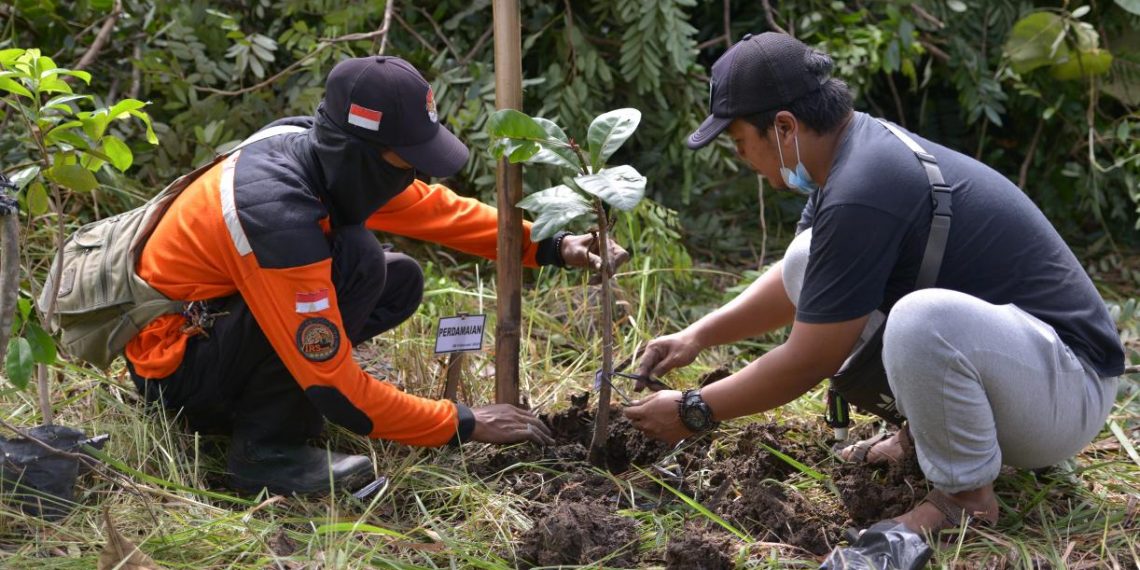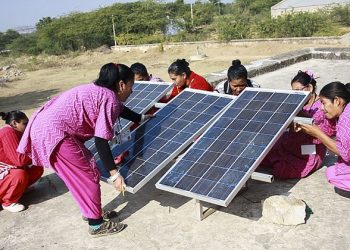Many people point to forest restoration as a way to curb climate change, where replanted forests sequester carbon in trees and soils. But emerging evidence shows that restoration can provide non-carbon climate benefits, too — in particular, reducing heat and regulating rainfall.
Here’s what we know, why it matters, and several opportunities on the horizon to expand our knowledge of the benefits of restoration for bringing back cooler, wetter conditions.
The Relationship Between Forests and Rainfall
Through the process of evapotranspiration, forests help recycle moisture that has blown in from seas and fallen as rain. Trees pump moisture from the soil back to the atmosphere, where it then condenses again and falls as rain, hundreds or even thousands of kilometers downwind. Water vapor released by forests can travel as far as 2,000 km away in the tropics and as far as 5,000 km in the temperate zone. In parts of the Western Amazon Basin, up to 50% of annual precipitation originates from the forest itself; up to 70% late in the dry season.
Given the important role forests have in recycling rainfall, removing them can disrupt rainfall patterns within and across national boundaries. In Borneo, watersheds that had lost more than 15% of their forests between 1973 and 2007 had a greater than 15% reduction in rainfall during that time. A model of deforestation in the Amazon predicted that if deforestation continues on its current trajectory, average annual rainfall by 2050 would drop by 8.1% across the region.
Can Forest Restoration Restore Rainfall?
While few studies have successfully measured the impacts of large-scale restoration on rainfall — and those that have been done have mostly focused on temperate latitude — emerging evidence shows that restoring degraded lands can improve precipitation.
One recent study showed that following the Chinese government’s massive Green for Grain program — the largest afforestation program in the world, where trees were planted on retired farmlands to reduce flooding and soil erosion — precipitation increased by 58%, or an average 54.62 mm per year over the afforested area. After trees were planted, atmospheric moisture entering the region decreased, but the amount of moisture falling as rain increased, as did the proportion of fallen rainfall that was recycled into future rainfall over the region.
In addition, several models predict that increasing tree cover would also increase precipitation. For example, models show that restoring Australia’s savanna ecosystems (which include trees) would increase rainfall by almost 10%, while increasing forest cover in Europe would increase average downwind precipitation by 7.6% during the summer months.
For the tropics, models predict that reforestation over the Sahel region could increase rainfall locally and downwind, increasing the intensity of heavy rain events, shortening the length of the dry season, and reversing the Niger River Basin’s overall drying trend. Contributors to the Science Panel for the Amazon, a leading authority on scientific, economic and moral issues related to conservation of the Amazon, anticipate that “forest restoration could help the Amazon maintain its hydrological integrity, with evapotranspiration from restored forests contributing to the east-west transfer of moisture.”
The Relationship Between Forests and Local Temperatures
Forests in temperate and tropical latitudes reduce local temperatures by directly blocking sunlight from reaching the ground. Additionally, through evapotranspiration and by creating wind turbulence, forests move moisture and latent heat higher into the atmosphere, cooling the earth’s surface and moderating local and regional temperature extremes. Surface temperatures in the tropics are on average .2 – 2.4 degrees C (.4 – 4.3 degrees F) cooler in forests than in nearby cleared areas, but temperature differences as high as 8.3 degrees C (14.9 degrees F) have been measured during the hottest part of the day.
In the Brazilian Amazon and Cerrado, researchers have detected the effects of deforestation on increased daily temperatures up to 50 km away from deforested areas.
Forests are especially effective at moderating temperature extremes during drier periods, improving local resilience to global warming. Reduced cloud coverage during dry spells increases solar radiation, causing trees to photosynthesize more and therefore pump more moisture from deep in the soil to the atmosphere, cooling the air.
Forest cover in the tropics provides the greatest cooling benefits. The combined biophysical cooling effects of tropical forests are so significant that, when combined with the effects of global emissions-related warming, their loss can double the local warming caused by global emissions alone. At the global scale, tropical forest loss effectively amplifies the warming effects of deforestation-related emissions by about 50%.
Can Forest Restoration Also Restore Cooler Temperatures?
An increasing body of evidence shows that restoring tree cover can reverse the effects of deforestation on local temperatures. However, that effect can vary, depending on the latitude at which the deforestation occurs, among other factors.
One study found that reforestation and afforestation in the tropics and temperate regions from 2000-2010 reduced the warming effects of deforestation by 0.2 degrees C (0.3 degrees F). Increasing tree cover in the boreal region had no effect, likely because snow-covered ground reflects more heat away from the earth’s surface than a forest. Models show that increasing tree cover in the Sahel could reduce local temperatures in some areas and increase them in others. In urban heat islands — areas of higher temperatures within cities — large trees planted for shade can mitigate the most intense heat by shielding the sun and cooling via evapotranspiration.
Adding trees to agricultural landscapes (where ecologically appropriate) can also mitigate local temperature extremes and boost yields. Livestock are vulnerable to heat stress, which can negatively affect growth, meat and milk production, reproduction and disease. One study comparing tropical savannas where livestock grazing occurs found that the cooling benefits of trees increased linearly with the amount of carbon stored in trees: each additional 10 metric tons of carbon stored per hectare were associated with cooler local temperatures of 0.83 degrees C (1.5 degrees F) in Africa and 1.1 degrees C (2.0 degrees F) in the Americas.
While such findings do not prove that adding trees to degraded landscapes results in cooling, recent research based on historical data suggests that it can: Trees planted during the 1930s Great Plains Shelterbelt initiative, which spanned from Northern Texas to the U.S.-Canada border, lowered regional temperature averages by 1.7-2.1%, reduced the number of extreme heat days by 12.9%, and increased precipitation by 4.4-8.0%. Ultimately, these changes increased corn yields by 54.3% and influenced farmer decisions about which crops to grow.
In the tropics, there is evidence that increased temperatures due to tree cover loss can decrease crop yields, while adding trees to farms — a practice known as agroforestry — can protect crops from heat stress. In Brazil, land conversion and forest losses from 1985-2021 decreased soy productivity by 6-12%, equivalent to lost profits of $158 per hectare. Meanwhile, agroforestry systems in Ethiopia have been modeled to increase national maize yields under future climate conditions by 3.1 – 7.5% compared to maize farms without trees.
These studies demonstrate that, in some cases, the addition of trees to agricultural landscapes can help crops and animals adapt to stresses brought on by greenhouse gas-induced climate change. Scientists contributing to the Science Panel for the Amazon concluded that increasing forest cover could provide additional benefits for society beyond agricultural producers by mitigating higher temperatures.
Why Do the Answers to These Questions Matter?
The dynamic between forest restoration and local cooling and precipitation has critical implications for people’s health, economies, agriculture and climate resilience.
Higher temperatures pose extreme risks to human health. One model showed that by 2100, conversion of the Brazilian Amazon to savanna could expose an additional 11 million people to heat stress. In Indonesia, a study demonstrated that worker productivity declined by over 8% in deforested areas due to reduced work quality and workers needing to operate more slowly and take more frequent breaks.
The biophysical effects of restored forests on local climate could add up to significant benefits for regional economies and food production. For example, of the 29 megacities in the world, 19 depend on rainfall recycled from land for greater than a third of their water supply. The potential for trees in agricultural landscapes to buffer yields are additional to other forms of agricultural adaptation to climate change, such as reducing soil erosion and providing pollinator habitat.
Mitigating the local impacts of global climate change is especially important for communities that are most vulnerable to such changes, such as Indigenous Peoples and local communities who are dependent on forest-based goods and services for meeting their basic needs, and others dependent on rain-fed agriculture in the tropics. The non-carbon benefits of forests for climate stability may be more immediately relevant to local, national and regional constituencies than forests’ carbon benefits, due to their ability to help humans adapt to warmer climates with more extreme weather.
Yet there is still much left to be learned about the degree to which forest restoration can help restore the non-carbon benefits of forests, thereby buffering local communities and national economies from the adverse effects of global greenhouse warming.
What Are the Opportunities to Learn More About Restoration’s Benefits?
There currently is unprecedented international interest in forest restoration. Initiatives such as the Bonn Challenge, AFR100 and Initiative 20×20 have set continental- to global-scale targets for ecosystem restoration. The UN declared 2021–2030 the UN Decade on Ecosystem Restoration. At the One Planet Summit in 2021, financial institutions committed $19.6 billion to restore degraded land and forests in Africa. And most recently, the Kunming-Montreal Global Biodiversity Framework, agreed at the Conventional on Biological Diversity COP15 in December 2022, set the global target of placing 30% of degraded ecosystems under restoration by 2030.
To continue to build widespread support for forest restoration across scales, the international restoration community must fully understand and communicate restoration’s full climate benefits. This includes the extent to which restored forests can regulate temperature and precipitation through non-carbon pathways, which is far less understood than the GHG effects of trees removing carbon from the atmosphere as they grow.
Importantly, incorporating non-carbon benefits into restoration planning could create new constituencies for forest restoration. While local communities and officials may feel powerless to affect the trajectory of global climate change, restoring forests and planting trees to stabilize local climates is something they can dig into. Research into this topic may give us answers that could help make a stronger case for restoration’s role in fighting climate change.
Several key questions to be answered through research include:
- To what extent can restored forests or increased tree cover in agricultural and urban areas predictably increase precipitation and mitigate extreme temperatures?
- At what resolution can we map pathways from where moisture evaporates over land to where it falls as rain, and the impacts of forest cover change?
- Can we quantify the extent to which the non-carbon climate benefits of restoration contribute to human health, agriculture and the economy, and put a price tag on those benefits?
- How can non-carbon benefits be incorporated into spatial planning for restoration?
- To what extent can large-scale forest restoration in the southern Amazon help the forest avoid passing its tipping point?
Large-scale restoration landscapes such as those in Brazil’s Atlantic Forest and the African Sahel, and afforestation initiatives such as China’s Green for Grain program, are coming into maturity and could be the basis of future studies that help us understand restoration’s full impacts on climate. Advances in remote sensing offer opportunities to explore these questions through empirical data. A portion of the energy and finance behind ongoing international initiatives can and should be channeled into supporting critical research.
The restoration research agenda is already quite broad. The addition of forests’ non-carbon benefits to this agenda would fill a critical gap.
Thanks to Carlos Nobre and Michael Wolosin, who also contributed to this article.



